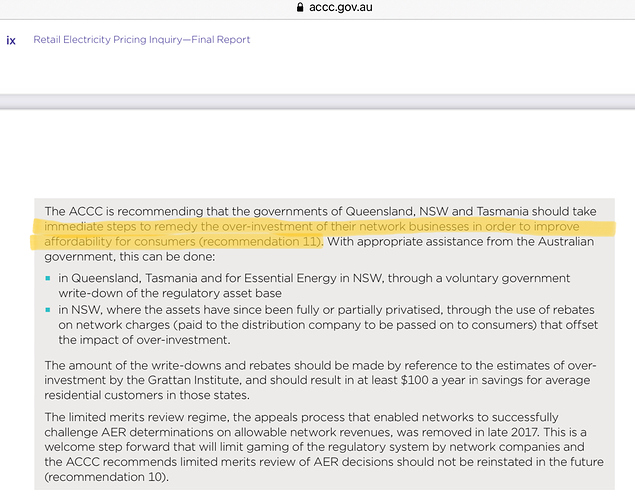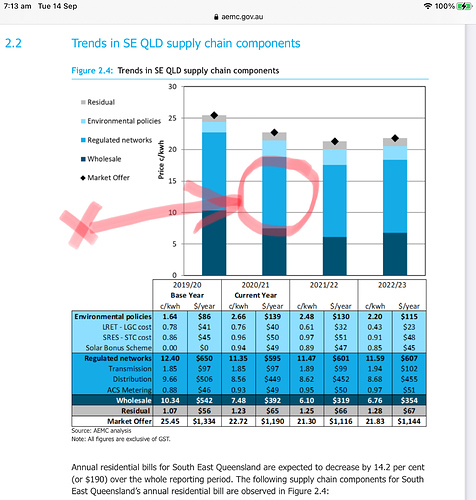A key point of the reset is that different practicable network options must be considered … not just one favoured by a network operator.
It is a frustrating process from those compiling the reset, as often there are multiple different network solutions to provide the forecasted needs on the network. Each solution (suite of solutions) needs to be considered and assessed.
I should also point out that the example by @allan.asher51 won’t fall under a reset. In relation to generator connection, these are usually dealt with differently and is a commercial agreement between the generator and the network operator. The same applies for large consumers which are connected to the grid (smelters, railways etc).
That isn’t correct. The AER, as part of the Reset review process, commissions it’s own expert consultants to review every component of the lodged reset. This is from forecasts, projects, costs etc. The consultants challenge the information provided and there is a lot of to and fro between parties for justification of the reset application and projects. Quite often projects put forward are not supported by the Reset decision, or the projects are modified to that seen as being reasonable. (This is challenging as quite often changes in projects for a reset period may result in cheaper reset project costs but could be seen as potentially higher long term costs due to rework etc).
The outcome of the reset is that determined by the regular and its consultants using the information provided by the network operators. Quite often the regular doesn’t provide revenue within the reset period for network nominated projects, alternative projects assessed as preferable by the AER/consultants are supported at expense of other projects and projects which are provided may be trimmed of revenue to that to which the regular and its consultants believe is reasonable. Due to changing forecasts, in later years there was a growing emphasis on asset life extension rather than replacement, which in some instances gave time to better understand the changing network conditions.
Network operations are very difficult to appreciate and complex…and often needs a team of experts to fully appreciate its operation and future needs. This is why the regulator, through reset review, engages a team of specialist experts to provide advice on the reset funding application. I suspect that there isn’t one person in Australia who full understands all the workings, forecasts and financial needs of all the network providers.
Possibly how the AER Reset works in a practicable sense isn’t fully understood by those outside the industry and maybe it is the role of the regular to provide information on how it works and why decisions are made. These decisions are focussed on lowering costs to the consumer.
One has to remember that network assets (distribution lines, transmission lines, substations, pipelines etc) have a life of 50+ years. One can’t point the finger at major failures in planning when bi-directional flow networks is a new concept driven in more recently times by dispersed small scale generators.
(Hindsight) criticism is only possible if the future is known.
If bidirectional flows were considered on the network say 20-50 years ago, then there would have been even more criticism of ‘gold plating’ as there was no need for bidirectional flows at those times. This is a limitation of the reset periods and also long term strategic planning as outlined in my first post.
Bidirectional flows principally has resulted from poor government policy in relation to small scale generation (where individual interests have in some ways overtaken over community (infrastructure) interests). The government policies possibly ignored in some ways the lifecycle of the network assets and the impacts by small scale generators. This has lead to the situation where we currently sit.
Edit:
Options for bidirectional flow would have been considered but possibly haven’t been supported as it doesn’t have a sufficient business case. 8-10 years ago network planners were discussing solutions for dispersed small scale generation and residential battery storage (household and EV cars) impacts on the network. There was discussion of options to manage peak demand by home/car battery support. There weren’t any projects in the reset I was involved in to cater for reverse/bidirectional flows, but planners had looked at such options. The AER hasn’t failed because it hasn’t forced investment for bidirectional flows. Possibly the AER should respond to why bidirectional flow projects haven’t got off the ground to allow individual small scale generation owners export as much as they chose. I know what the answer will be as it is unlikely to have changed in the past 8-10 years.


